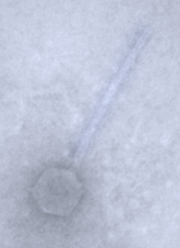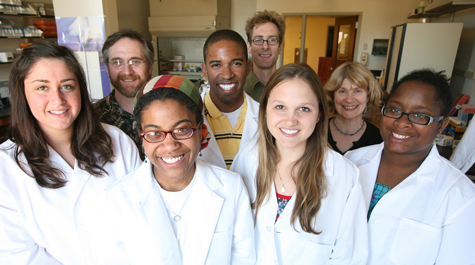Zero to co-authorship in under three years
William & Mary’s first freshman phage lab has demonstrated what possibly is the straightest learning curve known to science: zero to co-authorship in a peer-reviewed journal in under three years. Along the way, there was discovery of a form of life previously unknown to science—an organism which is now being examined as a possible biological tool to combat tuberculosis.
It started in fall 2008, a freshman lab section devoted to the study of a group of viruses known as bacteriophages. William & Mary was one of 12 universities selected by the Science Education Alliance of the Howard Hughes Medical Institute to participate in the first year of an initiative designed to re-invigorate science education by introducing the youngest college students to an authentic research experience.
 Each of the students in the year-long phage labs collects, isolates and analyzes a phage. One from the group is submitted to a commercial lab for genomic sequencing. The faculty involved say the publication of a paper in a peer-reviewed journal underscores the success of the teaching-through-research principle.
Each of the students in the year-long phage labs collects, isolates and analyzes a phage. One from the group is submitted to a commercial lab for genomic sequencing. The faculty involved say the publication of a paper in a peer-reviewed journal underscores the success of the teaching-through-research principle.
“We work from this principle: There really isn’t any difference between our educational goals and our research goals,” explained Mark Forsyth, Dorman Family Distinguished Associate Professor of Biology at William & Mary. “The best way to accomplish an educational goal is to set out to do authentic discovery research. This paper was the final proof that this principle actually works.”
In January, participants in the 2008 inaugural phage lab joined their collaborators—including their three faculty mentors—as co-authors of a paper in the peer-reviewed journal PLoS One. The paper is an examination of the genomes of bacteriophages studied by the inaugural HHMI phage labs. It includes characterization of CrimD, the new phage discovered and isolated from the muck of William & Mary’s campus landmark Crim Dell by the first phage lab.
William & Mary’s student authors on “Expanding the Diversity of Mycobacteriophages: Insights into Genome Architecture and Evolution” are Hilary M. Whelan ’12, Kobie C. Gordon ’12, Samuel E. Harvey ’12, Arrykka S. Jackson ’12, Molly J. McDonough ’12, Allison M. Perz ’12 and Jillian M. Walton ’11. Forsyth is one of the faculty authors, along with Chancellor Professor of Biology Margaret Saha and Assistant Professor of Biology Kurt Williamson.
Williamson is a virologist, a specialist in phages and other viruses. He says HHMI’s choice of bacteriophages as a focus is inspired. “It’s a great model,” Williamson said. “The goal is to learn about genome sequencing and genome annotation—in other words, where the genes are and what the genes code for. The nice thing about phages is that they’re fairly small. They have only 40 to 100 genes that you have to figure out what they do. In terms of a project that has to be done in two semesters, this is a great benefit. ”
HHMI has funded three cohorts of the year-long freshman phage lab and Saha says that W&M will both continue and expand the phage lab. In addition to the freshmen phage lab, a new upper-level lab will be offered that allows students to take their study of the viruses to the next stage through a new collaborative class with the mass spectroscopy lab of J.C Poutsma, the Margaret Hamilton Professor of Chemistry at William & Mary. Saha noted that the idea for a “continuation” lab actually arose from a student in the first cohort, Arrykka Jackson, who asked at the end of the year, “Is this it? Can’t we continue this?”
“The biologists sequence the phages and that gives you the genetic code. Basically, what the genes do is encode for a bunch of proteins,” Poutsma said. “In the new upper-level lab, we’re going to try to identify what these proteins are. We’re going to chop ’em up and put ’em in my mass spec and weigh ’em. This is how we’ll move from genetics to proteomics.”
Saha says that the phage lab has been the most exciting thing she has participated in since coming to William & Mary. “This has just excited students in a profound and lasting way. This phage lab concept was a big risk on the part of HHMI. It was a big risk on the part of William & Mary, too, because nothing like this has been done before,” she said. “And there’s been just a huge payoff.”
















